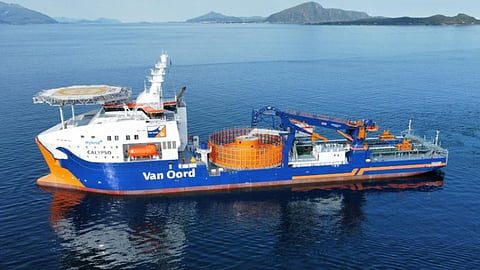Van Oord's newest cable-layer deploys for installation works at UK wind farm
Van Oord's newest cable-laying vessel has begun work on its first deployment, installing cables at the RWE-operated Sofia offshore wind farm in the UK.
Calypso is the second cable-lay vessel to join Van Oord's current active fleet and will be operated in support of offshore wind farm construction activities.
The vessel has an LOA of 129.8 metres, a moulded beam of 28 metres, a maximum draught of 6.9 metres, a depth of 9.8 metres, a gross tonnage of 9,675, a deadweight tonnage of 10,800, and accommodation for 90 crewmembers and technicians. The design is tailored for cable lay operations with an emphasis on enhanced seakeeping abilities and station keeping performances as well as low fuel consumption, hence the installation of a DP2 system.
The vessel was built by Vard and is designed with Vard Design's optimised hull form and bow shape incorporated in the design. Also fitted are an offshore crane and a secondary crane.
In addition to the cable carousel on the main deck, a second cable carousel is fitted below the main deck. The two carousels have a combined capacity of 8,000 tonnes.
The Sofia offshore wind farm is being constructed on Dogger Bank in the central North Sea, 195 kilometres from the North East coast of the UK. With a capacity of 1.4 GW, it will supply power to 1.2 million UK households.
RWE has contracted Van Oord for the design, engineering, procurement, construction, and installation (EPCI) of the monopile foundations and array cables for this project, with Calypso installing a total of approximately 360 kilometres of inter-array cables. The wind farm is scheduled to be fully operational in 2026.


